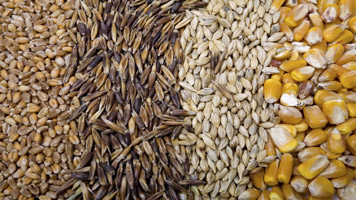 (AgriMoney) – Grain futures gave back a little more of their newly regained risk premium.
(AgriMoney) – Grain futures gave back a little more of their newly regained risk premium.
Not that the results of the likely key market event of the week, the Pro Farmer tour of the Midwest, were too promising.
For Ohio, for corn, the tour came in with a yield of 149.0 bushels per acre, only 0.6 bushels per acre above last year’s result, and well below the US Department of Agriculture forecast of a 163.0 bushels-per-acre result.
For soybeans, the tour indicated a soft result, showing an average pod count of 1,055.1 per 9 square feet, compared with 1,125.3 in 2015 and a three-year average of 1,250.4.
In South Dakota, the tour also indicated a weaker soybean result, with 970.6 pods per 9 square feet, down from 1,055.0 last year.
And for corn, the average yield estimate was 149.8 bushels per acre, down from 165.9 bushels per acre last year, and a three-year average result of 160.1 bushels per acre.
‘Expected to be the worst’
Still, there were at least two reasons for traders to put the data aside for now, the first being that weak results from the first day of the tour had been expected.
“Most of the yield samples that have been taken are nothing special,” said Benson Quinn Commodities.
However, “these were expected to be the worst areas for Corn Belt and that showed as scouts’ tweeted pictures of stubby corn, tip back and mixed yield results”.
If the results from the heart of the Corn Belt come in below expectations, that would likely do more to boost prices.
Ratings data
Furthermore, USDA data overnight raised questions over any attempt to diss US crop condition, with the proportion of corn rated “good” or “excellent” actually rising week on week, by one point to 75%, instead of falling a point as investors had expected.
(And indeed as is more usual at this time of year.)
For soybeans, the proportion of crop rated good or excellent held at 72% good or excellent.
While the rating in sodden Louisiana tumbled by 6 points to 53% good or excellent, that in Minnesota, where moisture is proving helpful to crops rather than excessive, rose 6 points to 61%.
Ukraine upgrade
Meanwhile, it was a little help that a rise in oil prices, whose buoyancy last week supported ags (many of which are converted into biofuels), continued a reversal this week.
Brent crude eased 0.3% to $49.00 a barrel, having touched $51.22 a barrel on Friday.
And wheat has returned to being a weight on the complex, sapped by talk of cut in Russia’s grain export tax, which affected Paris futures in particular in the last session, amid a round of strong former Soviet Union harvest results.
That continued on Tuesday, with UkrAgroConsult lifting by 1.7m tonnes to 62.7m tonnes its forecast for Ukraine’s grains harvest this year, including a 1.0m-tonne increase to 26.0m tonnes in the wheat harvest estimate.
Still, the respected analysis group highlighted promising early results from the Ukraine corn harvest too, noting that “warm weather and precipitation created favourable conditions for maize vegetation.
“Average productivity is expected to be an all-time high or close to a record high – nearly 6 tonnes per hectare – and gross production may reach 25m tonnes.”
Data later
At Chicago-based RJ O’Brien, Richard Feltes also flagged negative pressure on prices from “prospects for confirmation of a large Canadian crop” when Statistics Canada later unveils domestic production estimates.
These are expected to show Canadian wheat production at 30.4m tonnes, up from 27.6m tonnes last year, with some analysts seeing a figure as high as 32.6m tonnes, according to a Reuters poll.
(The USDA has a 30.0m-tonne estimate.)
For canola, a figure of 18.1m tonnes is expected, above last year’s 17.2m-tonne figure.
The USDA has pegged this year’s crop at 17.6m tonnes.
‘Furious pace of shipments’
Sure, there are some positive signs of demand, with Monday’s strong US export data for last week, as measured by cargo inspections, continuing to attract upbeat comment.
“US corn and soybean export paces look even more impressive with two weeks to go in 2015-16 crop year,” said Jerry Gidel at broker Price Futures.
For soybeans in particular, this could warrant an upgrade to the USDA estimate for shipments in the closing season, with a resulting cut to the estimate for closing inventories of the oilseed.
“Soybeans old-crop stocks could slip another 25m-30m bushels from August’s 250m-bushel forecast,” Mr Gidel said.
Benson Quinn Commodities said that, in soybeans, the “furious pace of US shipments in July and August could have USDA increasing export demand once again” in its September Wasde crop report.
“The pace of shipments in July and the first three weeks of August imply the USDA could increase exports another 30m bushels and lower old crop carryout to 225m bushels.
“This would take new crop carryout to 300m bushels.”
‘Torrid pace’
Still, RJ O’Brien’s Richard Feltes raised the question of whether the “torrid soy-buying pace” by China, the top importer, continue, rating the extent of further Chinese demand as one of the key factors ahead for determining prices.
Soybean futures for November as of 08:50 UK time (02:50 Chicago time) eased 0.7% to $10.08 ¾ a bushel.
Corn futures for December fell by 0.7% to $3.40 a bushel.
Wheat futures for December dropped 0.5% to $4.33 ¼ a bushel.
Wheat has its own demand story unfolding, in terms of top importer Egypt overnight announcing a tender, although this is expected, once again, to go to Black Sea origin.




